-
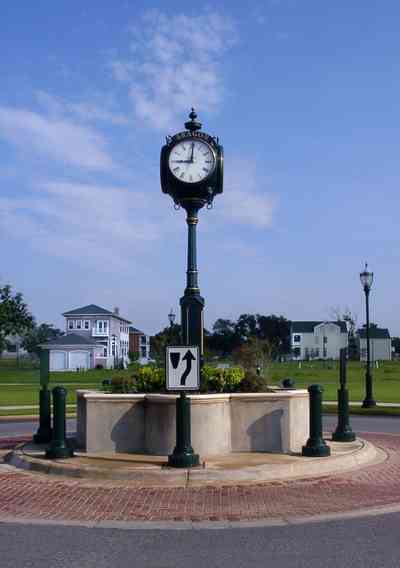
The traffic circle forms a centerpiece for the streetscape. It can be seen from 9th Avenue, Romana Street and Cevallos Street.
-
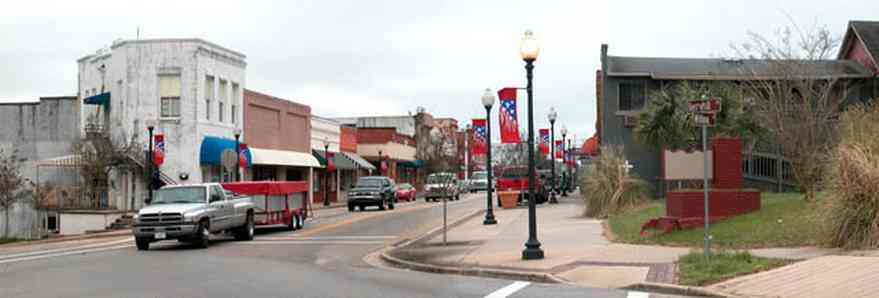
The downtown historic district joins the Blackwater River. Many of the restored storefront buildings can be seen on Willing Street.
-
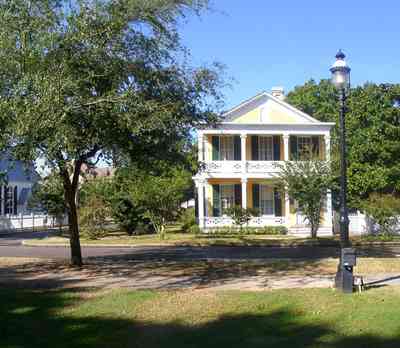
The Dorr House is located on the corner of Adams and Church Streets across from Seville Square.
-
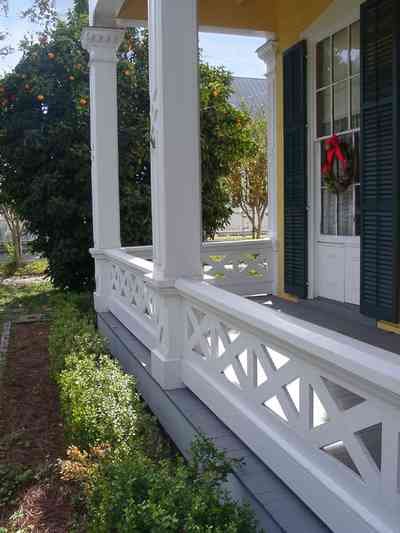
-
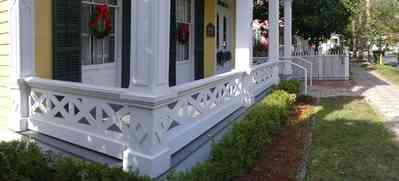
-
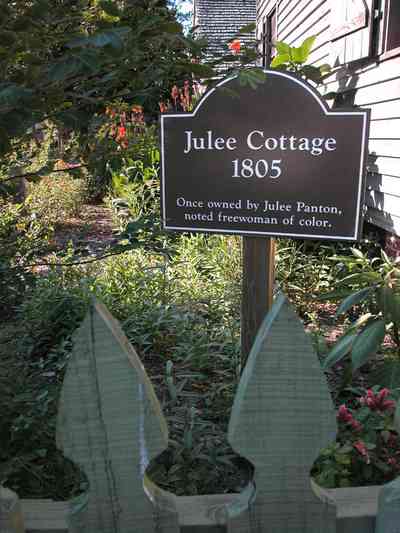
The historic marker can be seen from the sidewalk on Zaragoza Street. The cottage can be seen on the left. In 1804, Francis Heindenberg received from the Spanish governor a lot in the city of Pensacola. Four years later he sold the property to a free black woman named Julee. The sale included a “low wooden house which I have built at my own expense”. Both house and lot sold for three hundred dollars. The house was probably built between 1804 and 1808.
-
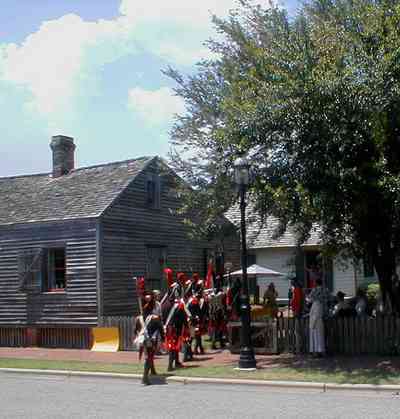
The Napoleanic Imperial Guard enters the village compound during the annual Spring Re-enactment event at the Historic Pensacola Village. The Julee cottage can be seen on the left.
-
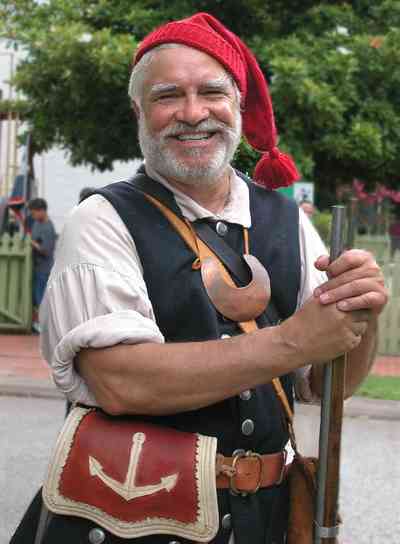
-

-
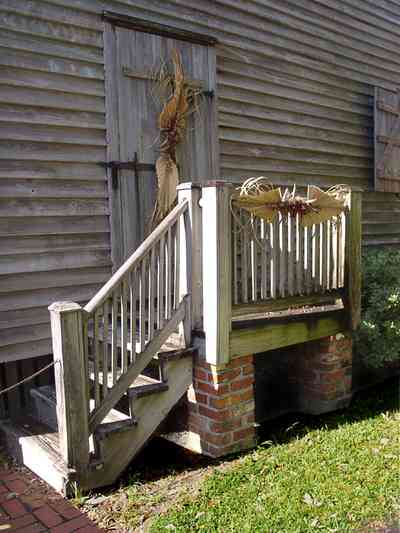
The cottage was moved to the village site as a demonstration of a typical dwelling of the period.
-
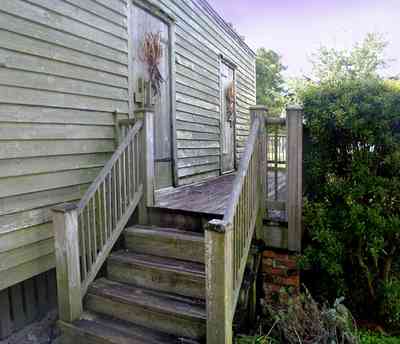
This is a north view of the cottage.
-
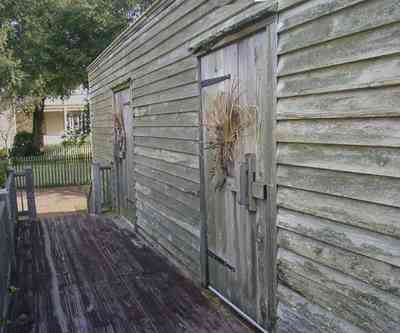
From the vantage point of the back porch of the cottage, the Lear House can be seen through the trees. The houses are separated by a picket fence.
-

At the northwest corner of the cottage, the facade of the Tivoli House can be seen.
-
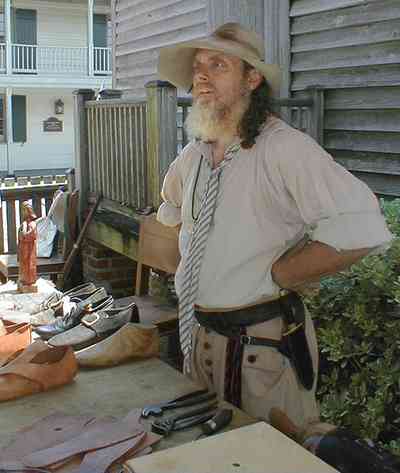
John Shaffer is a historical re-enactor. His is a cobbler by trade.
-
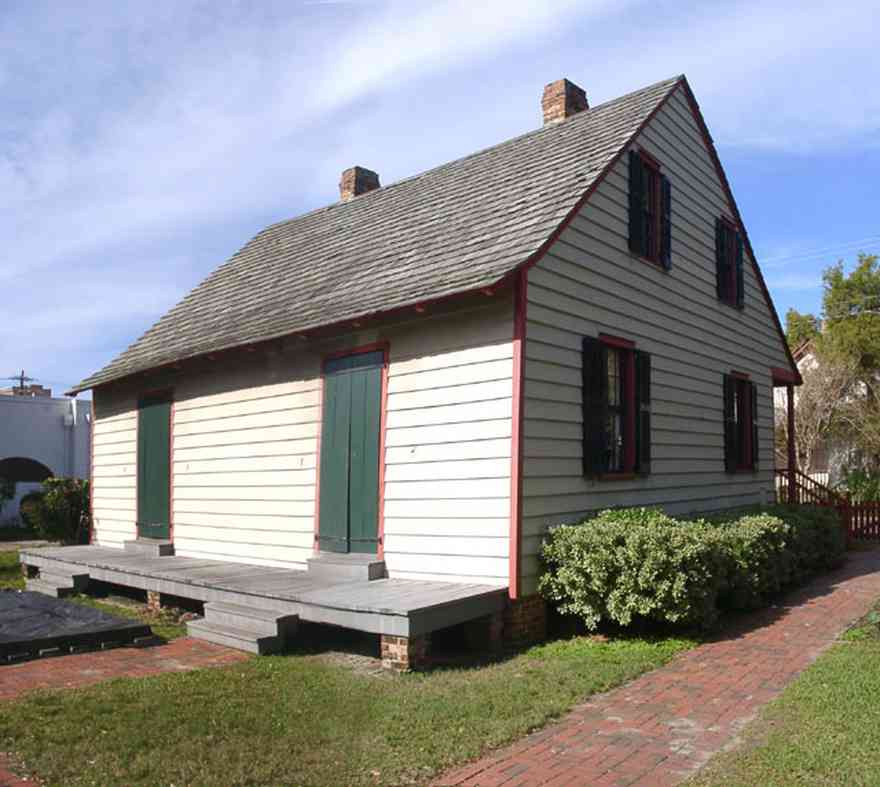
The LaValle House is located in the Pensacola Historic Village. The facade faces Church Street. It is separated from the Julee Cottage by a small green space.
-
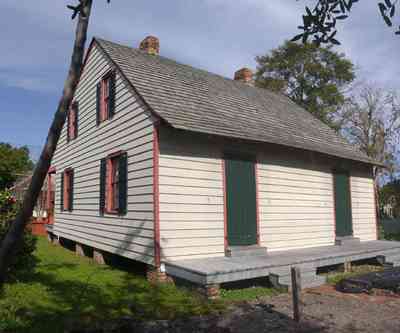
The rear of the cottage faces south.
-
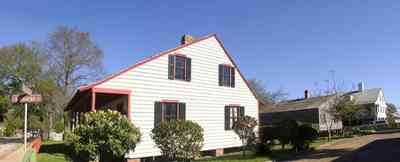
In this view three houses in the village complex can be seen. The Julee Cottage is directly behind the LaValle House. The Tivoli House is the last building on the right of the photograph.
-
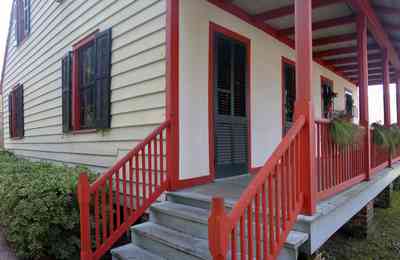
The front porch faces Church Street.
-
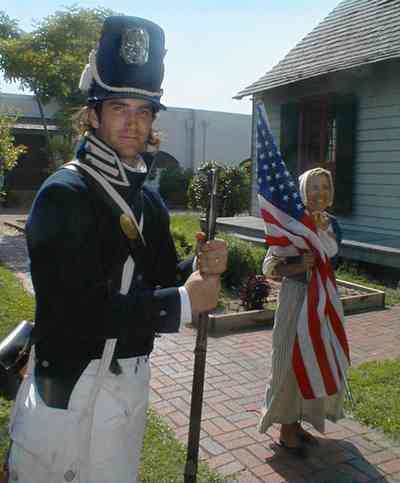
Lowell Basset poses as an 1812 US Infantryman. Gale Messerschmidt is dressed as an 1800's colonial lady in the 11th annual open house in the Historic Village.
-
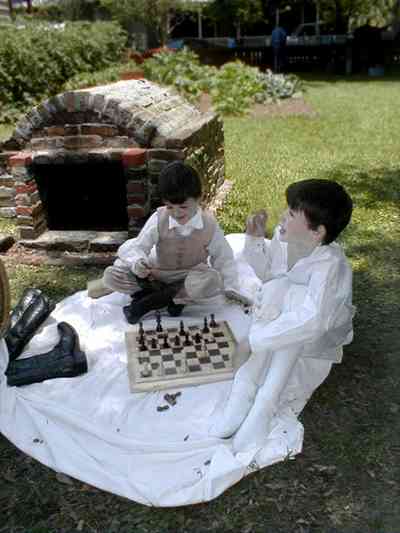
Two boys play chess as living history re-enactors during the summer open house at Historic Pensacola Village.
-

The Lear House was built in 1888. It is located on the north side of Zaragoza Street in the Pensacola Historic Village which is a complex of museums and historic houses in downtown Pensacola. For further information refer to the website at www.historic penscola.org The program is administrated by the State of Florida.
-
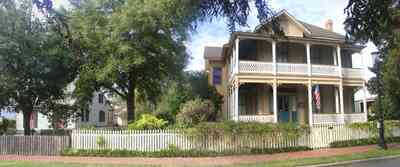
The Lear House is a museum in the Historic Village. The interior is furnished in the style of the 1920's.
-

A view from the west side of the first floor front porch. Zaragoza Street can be seen on the right and the interior yard of the home is on the left. The Lavalle Cottage Museum is in the far left corner of the site. There is a common kitchen garden and courtyard between the buildings.
-

West side view of the Lear House. The Lavalle Cottage is on the left of the frame. The Zaragoza Street trolley can be seen on the far right
-

A west view of the Lear House. Church Street is located to the north. The historic property encompasses the entire block. In the foreground one of the kitchen gardens and an outside oven can be seen. The Lavalle House is located on the right edge of the photograph.
-
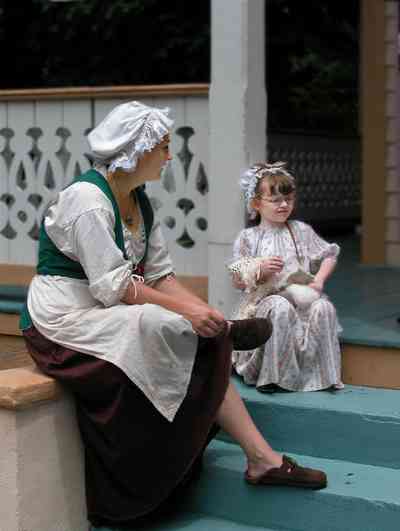
Colonial re-enactors give tours of the house during the yearly open house at the village.
-
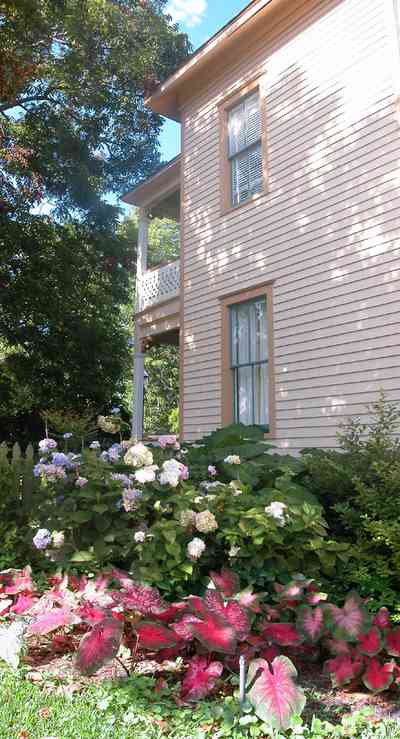
Old fashioned hydrangias add a nostalgic note to the gardening layout on the east sie of the home.
-
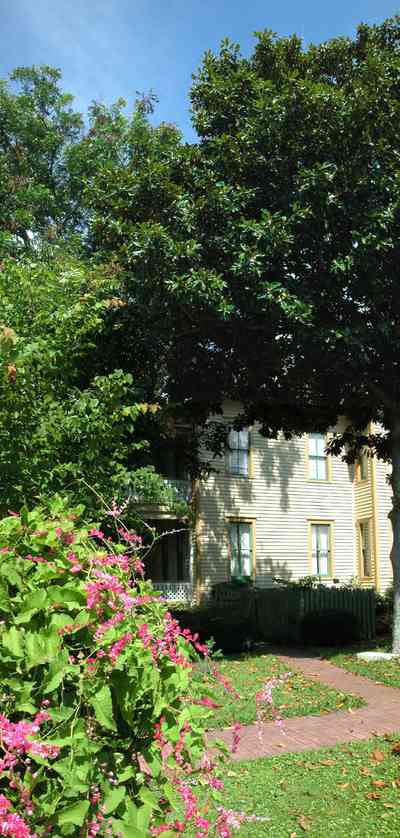
The picket fence along Zaragoza Street provides a place for blooming vines. The east side of the Lear House is in the background.
-
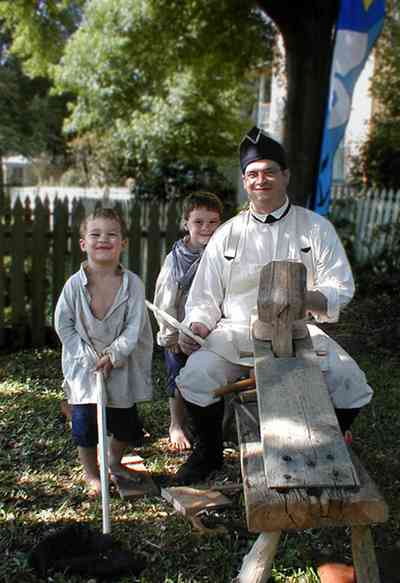
Tom Garret portrays a 1812 US Infantryman and woodworker. He is accompanied by his two sons who are also in period dress.
-
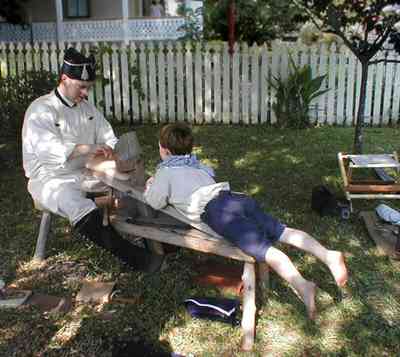
Tom and his sons are participating in the 11th Annual Summer Open House of the Historic Pensacola Village.
-
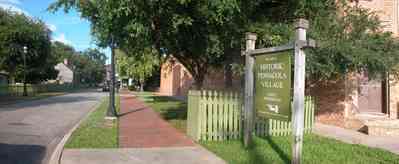
The museum is located on the corner of Zaragoza and Tarragona Streets. The sign on the right designates the official entrance to Historic Pensacola Village. The village is located in the heart of one of the oldest historic districts in the Southeast: the Seville Historic District in Pensacola. Listed on the National Register of Historic Places, the Sevilel Historic District is located on Pensacola Bay.
-
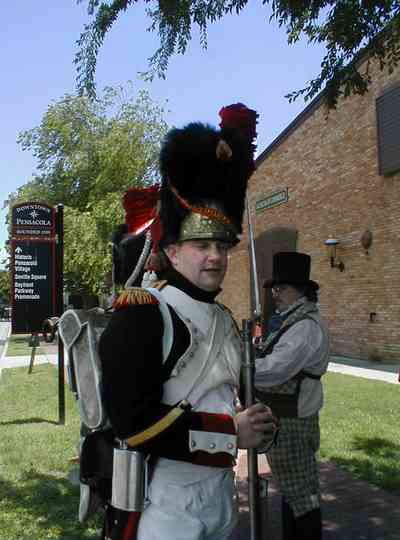
The soldier is part of the Napoleanic Imperial Guard from New Orleans, Louisiana. The group is taking part in the 11th Annual Summer Open House at the Historic Pensacola Village.
-
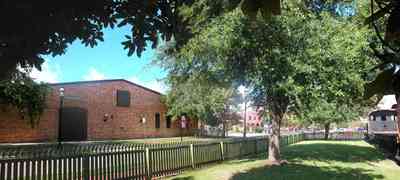
The Museum of Commerce and the Museum of Industry flank the enterance to Historic Pensacola Village. The museums are separated by Zaragoza Street.
-
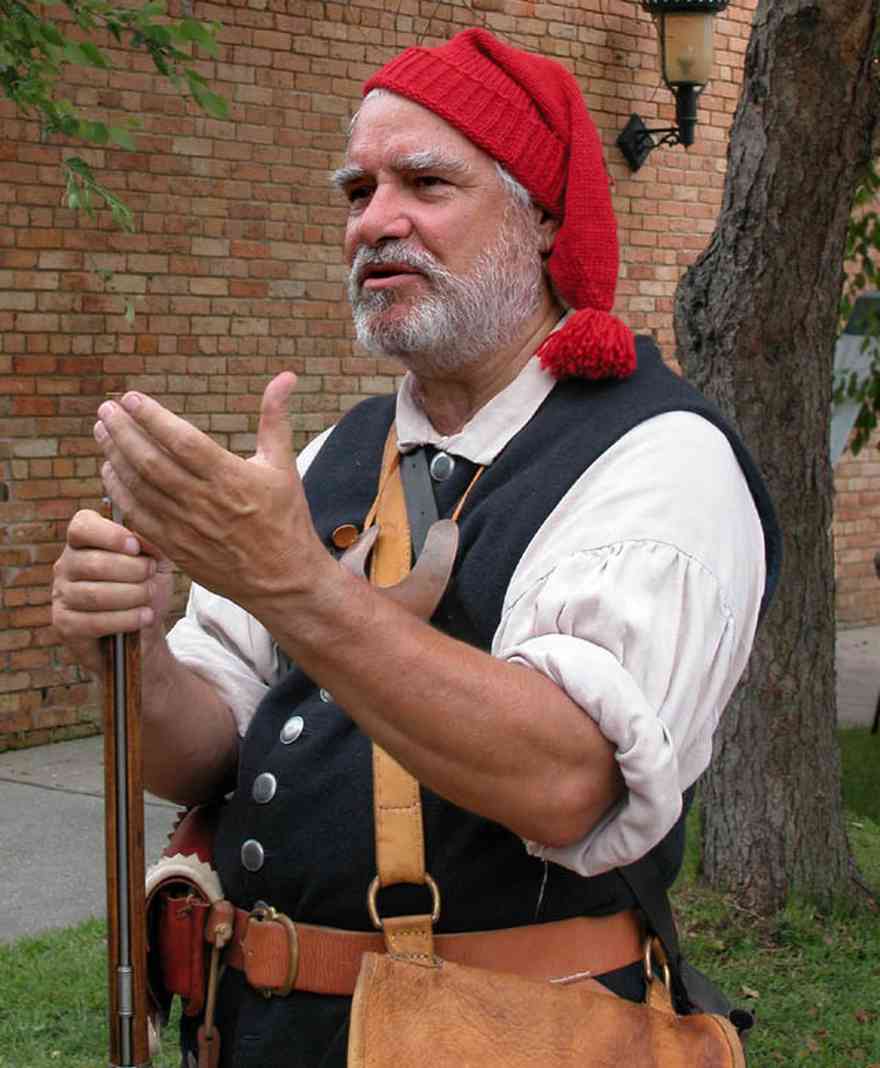
-

Gordon Levi demonstrates printing techniques at the 11th Annual Summer Open House at the Historic Pensacola Village.
-
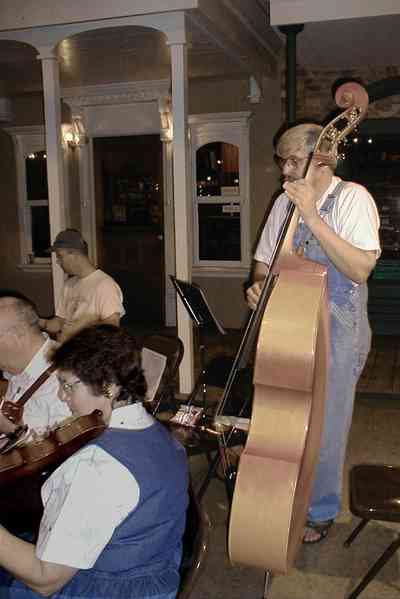
The Dogwood Dulcimer Associated entertains the crowds at the annual summer re-enactments in the museum.
-

-
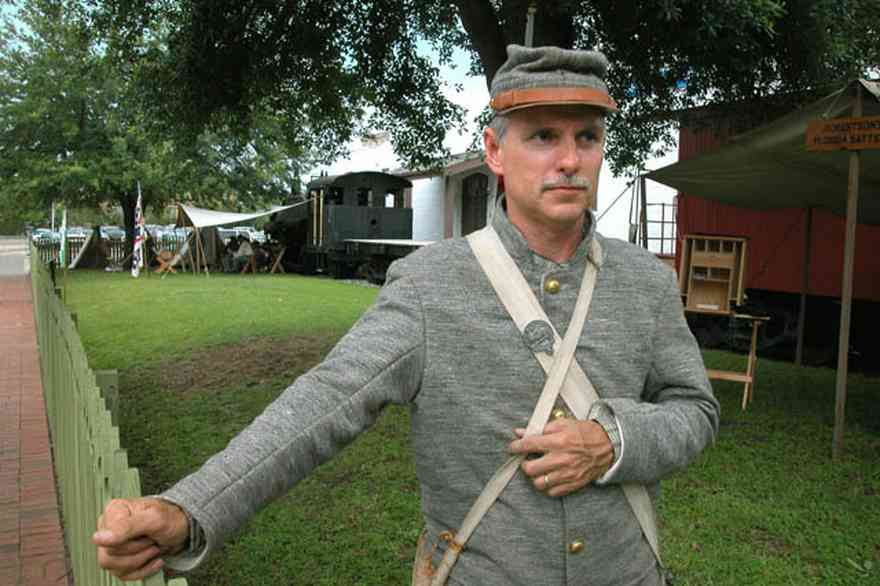
-
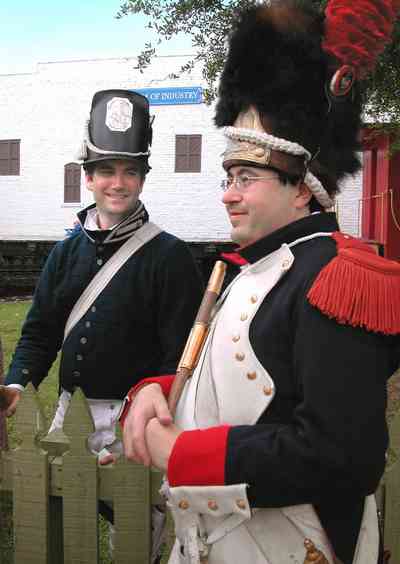
-

The plaque is located on the front of the church on the right side of the door.
-

The plaque is located on the front of the church on the right side of the door.
-
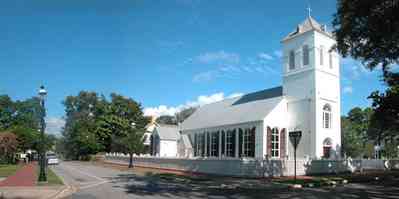
The church does not have a clear style since it has evolved over time. It has been described as Gothic. In 1832, the church was built for $4,500.00. In the late 1990’s the Historic Pnesacola Preservation Board spend $800,000.00 to rehabilitate the church.
-
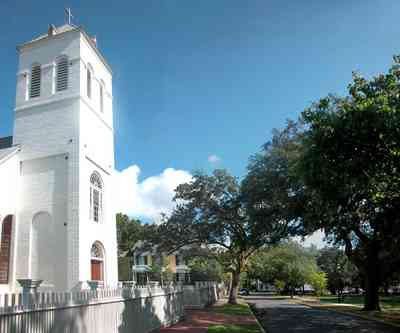
Originally the building was slicked with a white-colored lime wash to support the weak bake-fired bricks with which it was constructed.
-
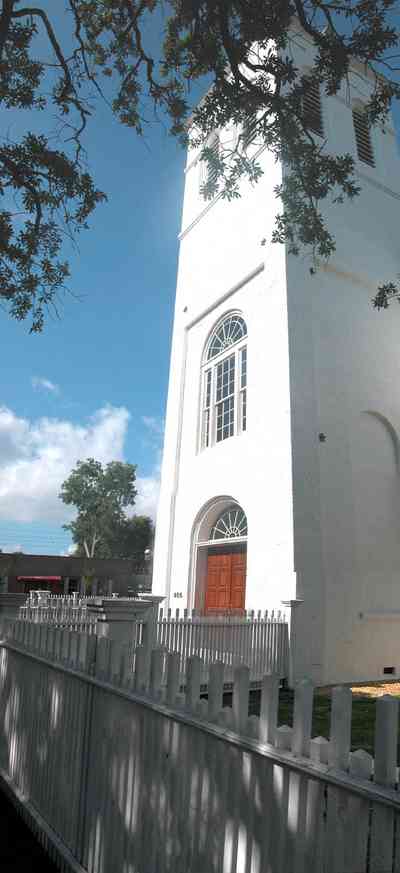
For a brief while during the Civil War, the entire congregation of Old Christ Church along with all but about 80 of Pensacola’s population, fled to Alabama. During their absence, Union troops occupied the church and used it as a hospital and barracks.
-
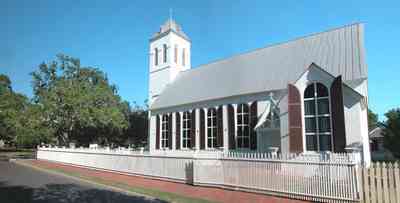
This is a north view from the vantage point of Church Street.
-
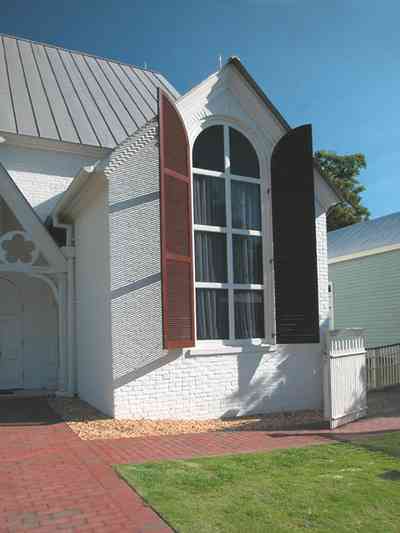
Today the building is at the center of Historic Pensacola Village to be used for concerts, recitals, lectures, adn weddings as well as a community town hall.
-
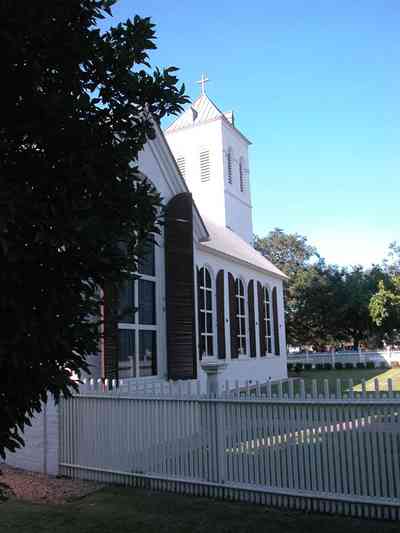
The south side of the church is on Zaragoza Street.
-
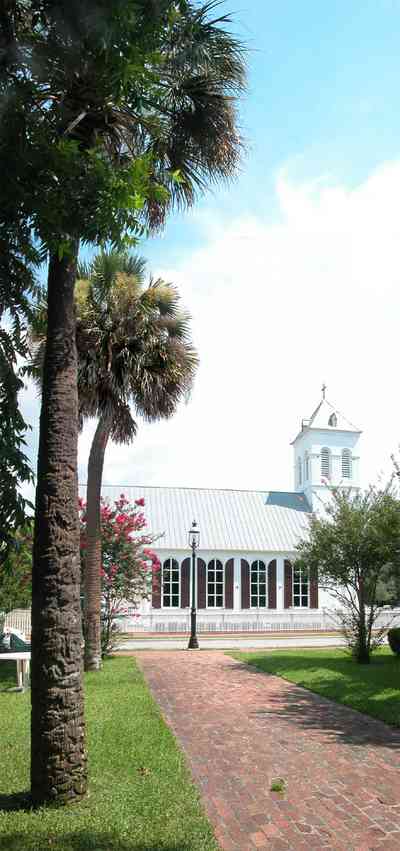
The Christ Church Episcopal parishioners moved into a new church on north Palafox in 1903. The Episcopal Bishop of Florida deconsecrated the building 1935. The building served as the first public library until 1959. Between 1959 and 1995, Pensacola Historical Museum based itself in the bulding, but by 1995 the church had again fallen into disrepair. In 1995, the city voted to return the deed to Old Christ Church vestry who in turn leased it to Historic Pensacola to make it eligible for state grants to fund the necessary repairs.
-
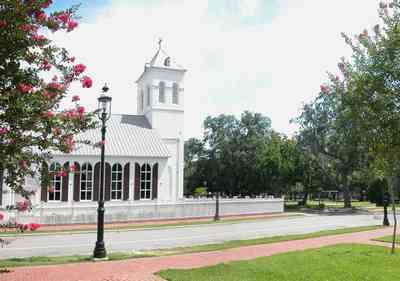
Old Christ Church is situated on the corner of Adams and Zaragoza Street across from Seville Square, as can be seen in the photograph.
-
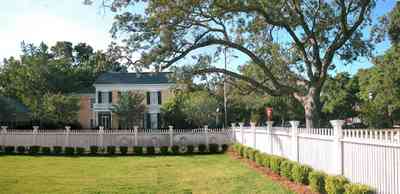
The Dorr House can be seen across the front lawn.
-
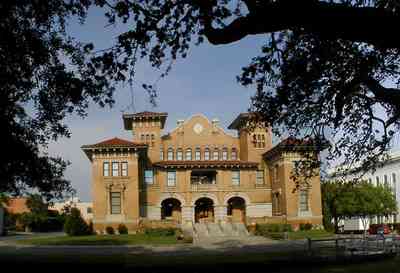
This view of the facade of the museum can be seen from Plaza Ferdinand.
-
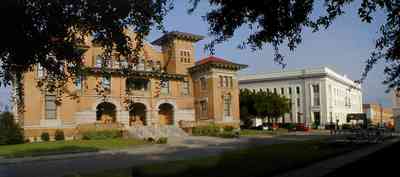
The Cultural Center is the white three-story building on the right of the photograph.
-
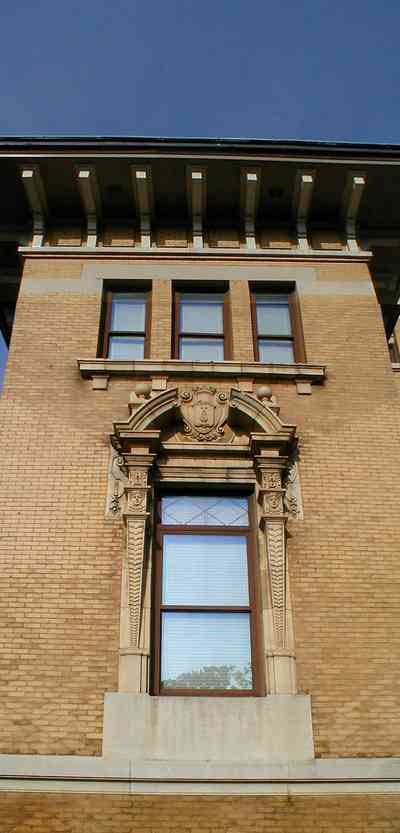
This is a closeup of a first floor window.
-
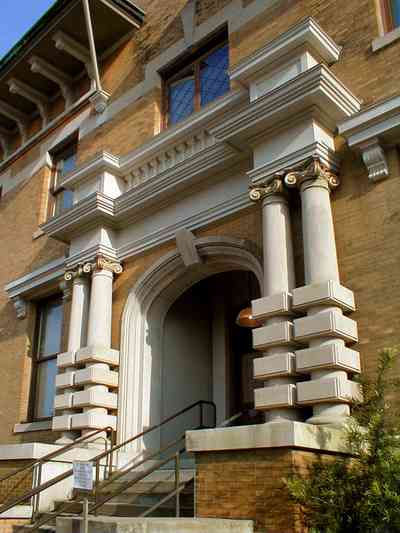
The building has identical entrances on the north and south facades.
-
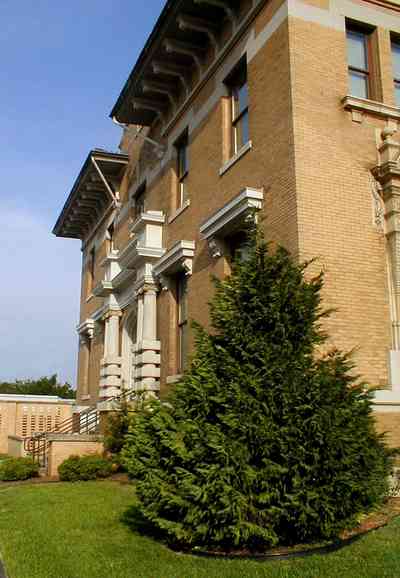
-
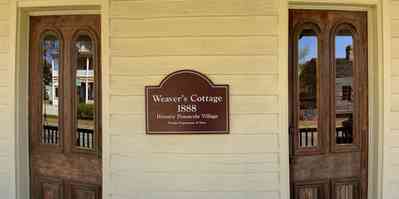
The viewer is facing the front doors of the cottage on the porch. A reflection of the Lear House can be seen in the window of the door on the left.
-
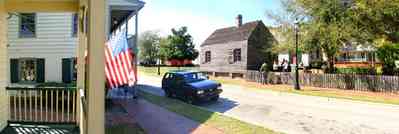
The viewer faces west from the vantage point of the porch. The Julee cottage is center frame and the side garden of the Lear House is on the right.
-
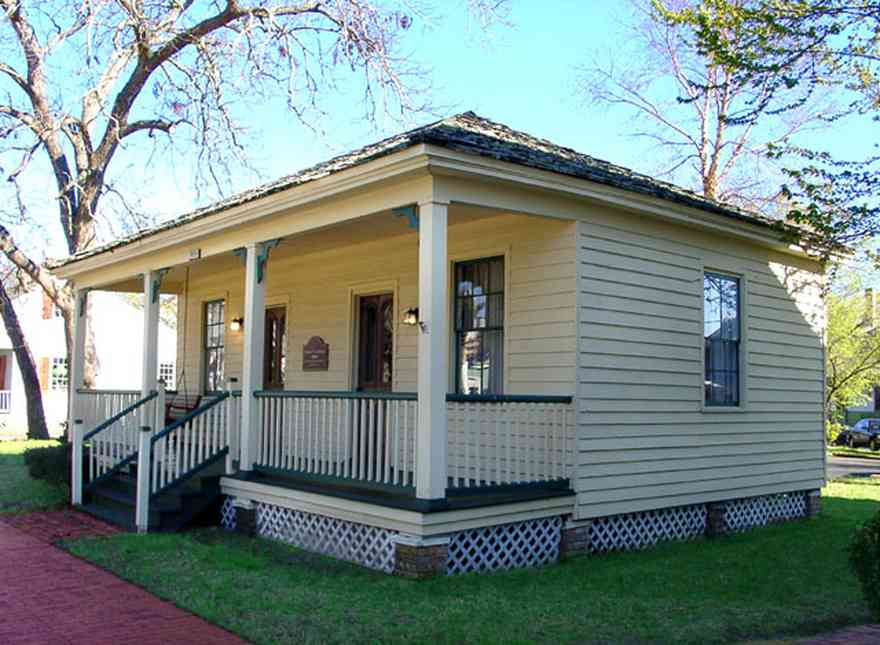
The cottage dates from 1880. It is used as a Historic Village museum displaying tools and implements of the weaver's trade.
-
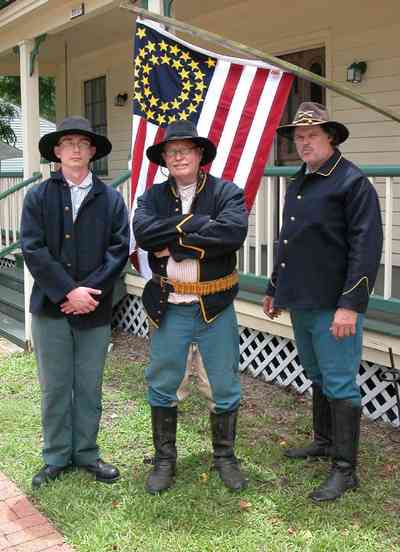
-
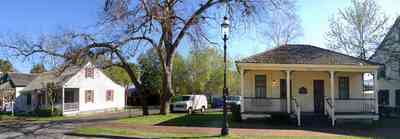
The streetscape shows the Weaver's Cottage Museum flanked to the right by the side of the Tivoli High House and to the left by the Seville Mechantile Store. The buildings are located on the south side of Zaragoza Street and are directly across from the Lear House.
-

The streetscape shows the Weaver's Cottage Museum flanked to the right by the side of the Tivoli High House and to the left by the Seville Mechantile Store. The buildings are located on the south side of Zaragoza Street and are directly across from the Lear House.
-

The streetscape shows the Weaver's Cottage Museum flanked to the right by the side of the Tivoli High House and to the left by the Seville Mechantile Store. The buildings are located on the south side of Zaragoza Street and are directly across from the Lear House.
-
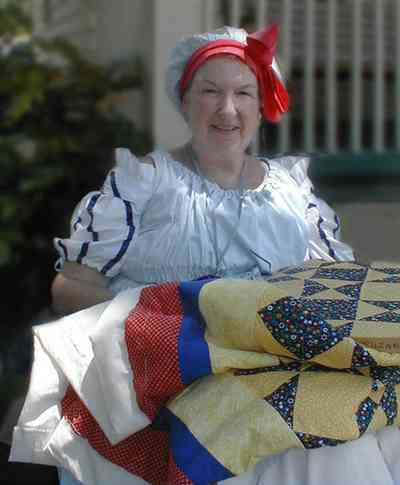
Nancy Wernicke demonstrates colonial quilting styles and techniques at the 11th annual Summer Open House at the Historic Pensacola Village.
-

Nora Nicosia, Joseph Everett and Tres Stoltz depict a French battalion in the early 1800's. The group are members of le Bataillon D'Orleans. The re-enactment is part of the yearly open house in the historic village.
-
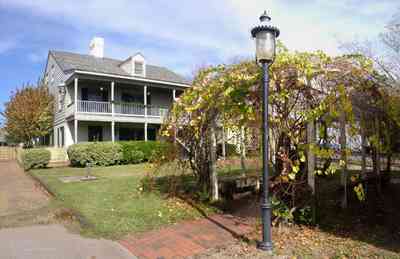
The rear of the Tivoli House faces a courtyard and arbor.
-
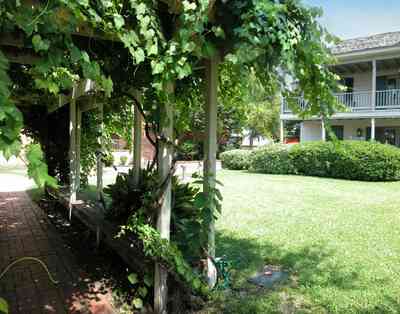
The arbor offers sheltered seating during the hottest time of day.
-
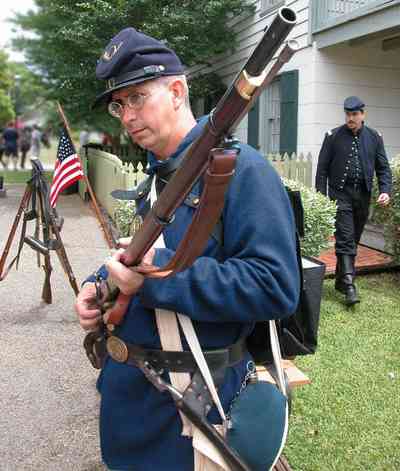
-
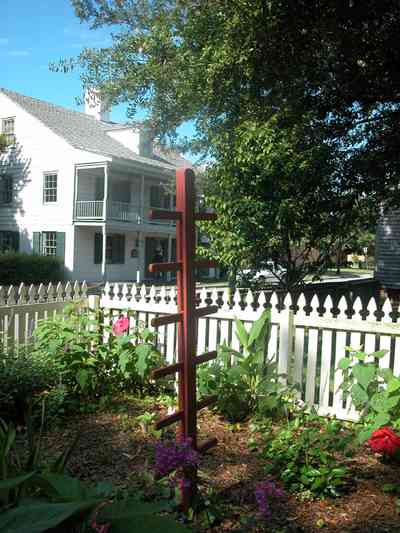
A profusion of summer flowers of the period can be seen in the gardens around the Lear-Rocheblave House. The Tivoli House canb e seen in the background of the photograph.
-
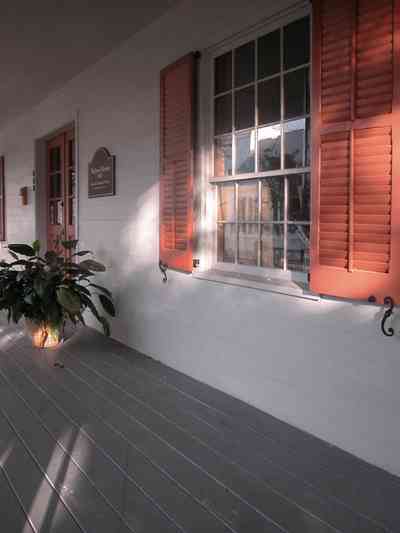
An apron porch with an overhang helps keep the house cool during the hot Gulf Coast summers.
-
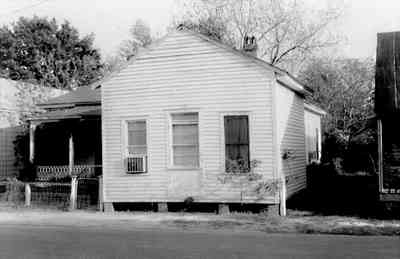
In this dramatic "before" picture, the state of the historic district before the preservation movement began is clearly demonstrated. This is a facade view which shows another house attached to the front right side. A small portion of the front porch can be seen to the left.
-

The home is located on Zaragoza Street. It faces north. The streetscape shows a variety of Victorian cottages dating from the 1870's.
-
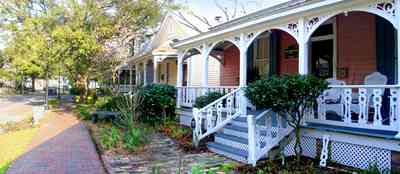
This eastern view of the home shows the brick sidewalks in the Historic District. The infrastructure includes underground utilities and decorative lanterns.
-
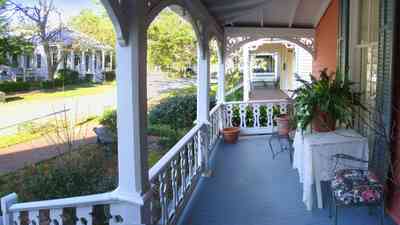
The porch of the home and the neighboring houses reflect a series of outdoor living rooms which function as a public space. This view shows the northeast corner of Florida Blanca and Zaragoza Street.
-
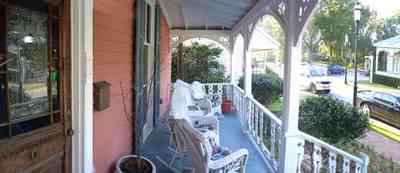
In this view to the west of the Trawick building, the neighboring structure across the street is located to the north. Jamie's Restaurant has a large parking lot on the west side.
-

A complete view of the neighborhood is seen from the front porch from Florida Blanca Street on the right to Cleland Antique Shop on the far left.

 The traffic circle forms a centerpiece for the streetscape. It can be seen from 9th Avenue, Romana Street and Cevallos Street.
The traffic circle forms a centerpiece for the streetscape. It can be seen from 9th Avenue, Romana Street and Cevallos Street. The downtown historic district joins the Blackwater River. Many of the restored storefront buildings can be seen on Willing Street.
The downtown historic district joins the Blackwater River. Many of the restored storefront buildings can be seen on Willing Street. The Dorr House is located on the corner of Adams and Church Streets across from Seville Square.
The Dorr House is located on the corner of Adams and Church Streets across from Seville Square.

 The historic marker can be seen from the sidewalk on Zaragoza Street. The cottage can be seen on the left. In 1804, Francis Heindenberg received from the Spanish governor a lot in the city of Pensacola. Four years later he sold the property to a free black woman named Julee. The sale included a “low wooden house which I have built at my own expense”. Both house and lot sold for three hundred dollars. The house was probably built between 1804 and 1808.
The historic marker can be seen from the sidewalk on Zaragoza Street. The cottage can be seen on the left. In 1804, Francis Heindenberg received from the Spanish governor a lot in the city of Pensacola. Four years later he sold the property to a free black woman named Julee. The sale included a “low wooden house which I have built at my own expense”. Both house and lot sold for three hundred dollars. The house was probably built between 1804 and 1808. The Napoleanic Imperial Guard enters the village compound during the annual Spring Re-enactment event at the Historic Pensacola Village. The Julee cottage can be seen on the left.
The Napoleanic Imperial Guard enters the village compound during the annual Spring Re-enactment event at the Historic Pensacola Village. The Julee cottage can be seen on the left.

 The cottage was moved to the village site as a demonstration of a typical dwelling of the period.
The cottage was moved to the village site as a demonstration of a typical dwelling of the period. This is a north view of the cottage.
This is a north view of the cottage. From the vantage point of the back porch of the cottage, the Lear House can be seen through the trees. The houses are separated by a picket fence.
From the vantage point of the back porch of the cottage, the Lear House can be seen through the trees. The houses are separated by a picket fence. At the northwest corner of the cottage, the facade of the Tivoli House can be seen.
At the northwest corner of the cottage, the facade of the Tivoli House can be seen. John Shaffer is a historical re-enactor. His is a cobbler by trade.
John Shaffer is a historical re-enactor. His is a cobbler by trade. The LaValle House is located in the Pensacola Historic Village. The facade faces Church Street. It is separated from the Julee Cottage by a small green space.
The LaValle House is located in the Pensacola Historic Village. The facade faces Church Street. It is separated from the Julee Cottage by a small green space. The rear of the cottage faces south.
The rear of the cottage faces south. In this view three houses in the village complex can be seen. The Julee Cottage is directly behind the LaValle House. The Tivoli House is the last building on the right of the photograph.
In this view three houses in the village complex can be seen. The Julee Cottage is directly behind the LaValle House. The Tivoli House is the last building on the right of the photograph. The front porch faces Church Street.
The front porch faces Church Street. Lowell Basset poses as an 1812 US Infantryman. Gale Messerschmidt is dressed as an 1800's colonial lady in the 11th annual open house in the Historic Village.
Lowell Basset poses as an 1812 US Infantryman. Gale Messerschmidt is dressed as an 1800's colonial lady in the 11th annual open house in the Historic Village. Two boys play chess as living history re-enactors during the summer open house at Historic Pensacola Village.
Two boys play chess as living history re-enactors during the summer open house at Historic Pensacola Village. The Lear House was built in 1888. It is located on the north side of Zaragoza Street in the Pensacola Historic Village which is a complex of museums and historic houses in downtown Pensacola. For further information refer to the website at www.historic penscola.org The program is administrated by the State of Florida.
The Lear House was built in 1888. It is located on the north side of Zaragoza Street in the Pensacola Historic Village which is a complex of museums and historic houses in downtown Pensacola. For further information refer to the website at www.historic penscola.org The program is administrated by the State of Florida. The Lear House is a museum in the Historic Village. The interior is furnished in the style of the 1920's.
The Lear House is a museum in the Historic Village. The interior is furnished in the style of the 1920's. A view from the west side of the first floor front porch. Zaragoza Street can be seen on the right and the interior yard of the home is on the left. The Lavalle Cottage Museum is in the far left corner of the site. There is a common kitchen garden and courtyard between the buildings.
A view from the west side of the first floor front porch. Zaragoza Street can be seen on the right and the interior yard of the home is on the left. The Lavalle Cottage Museum is in the far left corner of the site. There is a common kitchen garden and courtyard between the buildings. West side view of the Lear House. The Lavalle Cottage is on the left of the frame. The Zaragoza Street trolley can be seen on the far right
West side view of the Lear House. The Lavalle Cottage is on the left of the frame. The Zaragoza Street trolley can be seen on the far right A west view of the Lear House. Church Street is located to the north. The historic property encompasses the entire block. In the foreground one of the kitchen gardens and an outside oven can be seen. The Lavalle House is located on the right edge of the photograph.
A west view of the Lear House. Church Street is located to the north. The historic property encompasses the entire block. In the foreground one of the kitchen gardens and an outside oven can be seen. The Lavalle House is located on the right edge of the photograph. Colonial re-enactors give tours of the house during the yearly open house at the village.
Colonial re-enactors give tours of the house during the yearly open house at the village. Old fashioned hydrangias add a nostalgic note to the gardening layout on the east sie of the home.
Old fashioned hydrangias add a nostalgic note to the gardening layout on the east sie of the home. The picket fence along Zaragoza Street provides a place for blooming vines. The east side of the Lear House is in the background.
The picket fence along Zaragoza Street provides a place for blooming vines. The east side of the Lear House is in the background. Tom Garret portrays a 1812 US Infantryman and woodworker. He is accompanied by his two sons who are also in period dress.
Tom Garret portrays a 1812 US Infantryman and woodworker. He is accompanied by his two sons who are also in period dress. Tom and his sons are participating in the 11th Annual Summer Open House of the Historic Pensacola Village.
Tom and his sons are participating in the 11th Annual Summer Open House of the Historic Pensacola Village. The museum is located on the corner of Zaragoza and Tarragona Streets. The sign on the right designates the official entrance to Historic Pensacola Village. The village is located in the heart of one of the oldest historic districts in the Southeast: the Seville Historic District in Pensacola. Listed on the National Register of Historic Places, the Sevilel Historic District is located on Pensacola Bay.
The museum is located on the corner of Zaragoza and Tarragona Streets. The sign on the right designates the official entrance to Historic Pensacola Village. The village is located in the heart of one of the oldest historic districts in the Southeast: the Seville Historic District in Pensacola. Listed on the National Register of Historic Places, the Sevilel Historic District is located on Pensacola Bay. The soldier is part of the Napoleanic Imperial Guard from New Orleans, Louisiana. The group is taking part in the 11th Annual Summer Open House at the Historic Pensacola Village.
The soldier is part of the Napoleanic Imperial Guard from New Orleans, Louisiana. The group is taking part in the 11th Annual Summer Open House at the Historic Pensacola Village. The Museum of Commerce and the Museum of Industry flank the enterance to Historic Pensacola Village. The museums are separated by Zaragoza Street.
The Museum of Commerce and the Museum of Industry flank the enterance to Historic Pensacola Village. The museums are separated by Zaragoza Street.
 Gordon Levi demonstrates printing techniques at the 11th Annual Summer Open House at the Historic Pensacola Village.
Gordon Levi demonstrates printing techniques at the 11th Annual Summer Open House at the Historic Pensacola Village. The Dogwood Dulcimer Associated entertains the crowds at the annual summer re-enactments in the museum.
The Dogwood Dulcimer Associated entertains the crowds at the annual summer re-enactments in the museum.


 The plaque is located on the front of the church on the right side of the door.
The plaque is located on the front of the church on the right side of the door. The plaque is located on the front of the church on the right side of the door.
The plaque is located on the front of the church on the right side of the door. The church does not have a clear style since it has evolved over time. It has been described as Gothic. In 1832, the church was built for $4,500.00. In the late 1990’s the Historic Pnesacola Preservation Board spend $800,000.00 to rehabilitate the church.
The church does not have a clear style since it has evolved over time. It has been described as Gothic. In 1832, the church was built for $4,500.00. In the late 1990’s the Historic Pnesacola Preservation Board spend $800,000.00 to rehabilitate the church. Originally the building was slicked with a white-colored lime wash to support the weak bake-fired bricks with which it was constructed.
Originally the building was slicked with a white-colored lime wash to support the weak bake-fired bricks with which it was constructed. For a brief while during the Civil War, the entire congregation of Old Christ Church along with all but about 80 of Pensacola’s population, fled to Alabama. During their absence, Union troops occupied the church and used it as a hospital and barracks.
For a brief while during the Civil War, the entire congregation of Old Christ Church along with all but about 80 of Pensacola’s population, fled to Alabama. During their absence, Union troops occupied the church and used it as a hospital and barracks. This is a north view from the vantage point of Church Street.
This is a north view from the vantage point of Church Street. Today the building is at the center of Historic Pensacola Village to be used for concerts, recitals, lectures, adn weddings as well as a community town hall.
Today the building is at the center of Historic Pensacola Village to be used for concerts, recitals, lectures, adn weddings as well as a community town hall. The south side of the church is on Zaragoza Street.
The south side of the church is on Zaragoza Street. The Christ Church Episcopal parishioners moved into a new church on north Palafox in 1903. The Episcopal Bishop of Florida deconsecrated the building 1935. The building served as the first public library until 1959. Between 1959 and 1995, Pensacola Historical Museum based itself in the bulding, but by 1995 the church had again fallen into disrepair. In 1995, the city voted to return the deed to Old Christ Church vestry who in turn leased it to Historic Pensacola to make it eligible for state grants to fund the necessary repairs.
The Christ Church Episcopal parishioners moved into a new church on north Palafox in 1903. The Episcopal Bishop of Florida deconsecrated the building 1935. The building served as the first public library until 1959. Between 1959 and 1995, Pensacola Historical Museum based itself in the bulding, but by 1995 the church had again fallen into disrepair. In 1995, the city voted to return the deed to Old Christ Church vestry who in turn leased it to Historic Pensacola to make it eligible for state grants to fund the necessary repairs. Old Christ Church is situated on the corner of Adams and Zaragoza Street across from Seville Square, as can be seen in the photograph.
Old Christ Church is situated on the corner of Adams and Zaragoza Street across from Seville Square, as can be seen in the photograph. The Dorr House can be seen across the front lawn.
The Dorr House can be seen across the front lawn. This view of the facade of the museum can be seen from Plaza Ferdinand.
This view of the facade of the museum can be seen from Plaza Ferdinand. The Cultural Center is the white three-story building on the right of the photograph.
The Cultural Center is the white three-story building on the right of the photograph. This is a closeup of a first floor window.
This is a closeup of a first floor window. The building has identical entrances on the north and south facades.
The building has identical entrances on the north and south facades.
 The viewer is facing the front doors of the cottage on the porch. A reflection of the Lear House can be seen in the window of the door on the left.
The viewer is facing the front doors of the cottage on the porch. A reflection of the Lear House can be seen in the window of the door on the left. The viewer faces west from the vantage point of the porch. The Julee cottage is center frame and the side garden of the Lear House is on the right.
The viewer faces west from the vantage point of the porch. The Julee cottage is center frame and the side garden of the Lear House is on the right. The cottage dates from 1880. It is used as a Historic Village museum displaying tools and implements of the weaver's trade.
The cottage dates from 1880. It is used as a Historic Village museum displaying tools and implements of the weaver's trade.
 The streetscape shows the Weaver's Cottage Museum flanked to the right by the side of the Tivoli High House and to the left by the Seville Mechantile Store. The buildings are located on the south side of Zaragoza Street and are directly across from the Lear House.
The streetscape shows the Weaver's Cottage Museum flanked to the right by the side of the Tivoli High House and to the left by the Seville Mechantile Store. The buildings are located on the south side of Zaragoza Street and are directly across from the Lear House. The streetscape shows the Weaver's Cottage Museum flanked to the right by the side of the Tivoli High House and to the left by the Seville Mechantile Store. The buildings are located on the south side of Zaragoza Street and are directly across from the Lear House.
The streetscape shows the Weaver's Cottage Museum flanked to the right by the side of the Tivoli High House and to the left by the Seville Mechantile Store. The buildings are located on the south side of Zaragoza Street and are directly across from the Lear House. The streetscape shows the Weaver's Cottage Museum flanked to the right by the side of the Tivoli High House and to the left by the Seville Mechantile Store. The buildings are located on the south side of Zaragoza Street and are directly across from the Lear House.
The streetscape shows the Weaver's Cottage Museum flanked to the right by the side of the Tivoli High House and to the left by the Seville Mechantile Store. The buildings are located on the south side of Zaragoza Street and are directly across from the Lear House. Nancy Wernicke demonstrates colonial quilting styles and techniques at the 11th annual Summer Open House at the Historic Pensacola Village.
Nancy Wernicke demonstrates colonial quilting styles and techniques at the 11th annual Summer Open House at the Historic Pensacola Village. Nora Nicosia, Joseph Everett and Tres Stoltz depict a French battalion in the early 1800's. The group are members of le Bataillon D'Orleans. The re-enactment is part of the yearly open house in the historic village.
Nora Nicosia, Joseph Everett and Tres Stoltz depict a French battalion in the early 1800's. The group are members of le Bataillon D'Orleans. The re-enactment is part of the yearly open house in the historic village. The rear of the Tivoli House faces a courtyard and arbor.
The rear of the Tivoli House faces a courtyard and arbor. The arbor offers sheltered seating during the hottest time of day.
The arbor offers sheltered seating during the hottest time of day.
 A profusion of summer flowers of the period can be seen in the gardens around the Lear-Rocheblave House. The Tivoli House canb e seen in the background of the photograph.
A profusion of summer flowers of the period can be seen in the gardens around the Lear-Rocheblave House. The Tivoli House canb e seen in the background of the photograph. An apron porch with an overhang helps keep the house cool during the hot Gulf Coast summers.
An apron porch with an overhang helps keep the house cool during the hot Gulf Coast summers. In this dramatic "before" picture, the state of the historic district before the preservation movement began is clearly demonstrated. This is a facade view which shows another house attached to the front right side. A small portion of the front porch can be seen to the left.
In this dramatic "before" picture, the state of the historic district before the preservation movement began is clearly demonstrated. This is a facade view which shows another house attached to the front right side. A small portion of the front porch can be seen to the left. The home is located on Zaragoza Street. It faces north. The streetscape shows a variety of Victorian cottages dating from the 1870's.
The home is located on Zaragoza Street. It faces north. The streetscape shows a variety of Victorian cottages dating from the 1870's. This eastern view of the home shows the brick sidewalks in the Historic District. The infrastructure includes underground utilities and decorative lanterns.
This eastern view of the home shows the brick sidewalks in the Historic District. The infrastructure includes underground utilities and decorative lanterns. The porch of the home and the neighboring houses reflect a series of outdoor living rooms which function as a public space. This view shows the northeast corner of Florida Blanca and Zaragoza Street.
The porch of the home and the neighboring houses reflect a series of outdoor living rooms which function as a public space. This view shows the northeast corner of Florida Blanca and Zaragoza Street. In this view to the west of the Trawick building, the neighboring structure across the street is located to the north. Jamie's Restaurant has a large parking lot on the west side.
In this view to the west of the Trawick building, the neighboring structure across the street is located to the north. Jamie's Restaurant has a large parking lot on the west side. A complete view of the neighborhood is seen from the front porch from Florida Blanca Street on the right to Cleland Antique Shop on the far left.
A complete view of the neighborhood is seen from the front porch from Florida Blanca Street on the right to Cleland Antique Shop on the far left. One Tank of Gas
One Tank of Gas